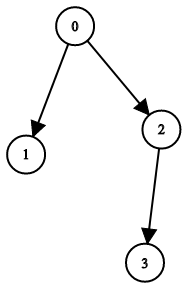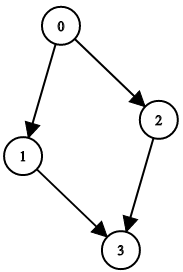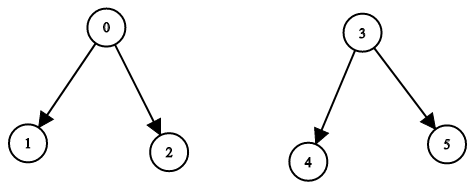You have n binary tree nodes numbered from 0 to n - 1 where node i has two children leftChild[i] and rightChild[i], return true if and only if all the given nodes form exactly one valid binary tree.
If node i has no left child then leftChild[i] will equal -1, similarly for the right child.
Note that the nodes have no values and that we only use the node numbers in this problem.
Example 1:

Input: n = 4, leftChild = [1,-1,3,-1], rightChild = [2,-1,-1,-1] Output: true
Example 2:

Input: n = 4, leftChild = [1,-1,3,-1], rightChild = [2,3,-1,-1] Output: false
Example 3:

Input: n = 2, leftChild = [1,0], rightChild = [-1,-1] Output: false
Example 4:

Input: n = 6, leftChild = [1,-1,-1,4,-1,-1], rightChild = [2,-1,-1,5,-1,-1] Output: false
class Solution {
public:
/*
single tree: one root: [one missing value in both of the lists] [otherwise false]
single parent: [If same value repeated ]
no cycle: [all the values appear means cycle]
*/
bool validateBinaryTreeNodes(int n, vector<int>& leftChild, vector<int>& rightChild) {
if (leftChild.size() != rightChild.size()) {
return false;
}
vector<bool> dp(n, true);
for (auto val : leftChild) {
if (val != -1) {
if (!dp[val]) {
return false;
}
dp[val] = false;
}
}
for (auto val : rightChild) {
if (val != -1) {
if (!dp[val]) {
return false;
}
dp[val] = false;
}
}
int root = -1;
int count = 0;
for (int i = 0; i < dp.size(); i++) {
bool val = dp[i];
if (val) {
root = i;
count++;
}
}
if (count != 1) {
return false;
}
if (!dfs(n, leftChild, rightChild, root)) {
return false;
}
return true;
}
bool helper(int root, vector<int>& leftChild, vector<int>& rightChild,
vector<int>& visited) {
if (visited[root] == 1) {
return false;
}
if (visited[root] == 2) {
return true;
}
visited[root] = 1;
if (leftChild[root] != -1) {
if (!helper(leftChild[root], leftChild, rightChild, visited)) {
return false;
}
}
if (rightChild[root] != -1) {
if (!helper(rightChild[root], leftChild, rightChild, visited)) {
return false;
}
}
visited[root] = 2;
return true;
}
bool dfs(int n, vector<int>& leftChild, vector<int>& rightChild, int root) {
vector<int> visited(n, 0);
if (!helper(root, leftChild, rightChild, visited)) {
return false;
}
for (auto val: visited) {
if (val == 0) {
return false;
}
}
return true;
}
};